University Report: Knowledge Management Issues and Solutions for HP
VerifiedAdded on 2020/05/16
|17
|4360
|102
Report
AI Summary
This report provides a comprehensive analysis of the knowledge management issues within Hewlett-Packard (HP). It identifies key problems stemming from HP's organizational structure, particularly its decentralized nature, which hinders effective knowledge sharing across different units. The report examines the impact of leadership styles, organizational culture, and human resource management (HRM) practices on knowledge management effectiveness. It highlights how the autonomous culture within HP's units, while fostering specialization, limits the overall organizational knowledge database and restricts the flow of information. The report delves into the principles of knowledge management, such as leadership, simplicity, and community of practice, and evaluates HP's performance against these principles. Finally, the report offers recommendations, including adopting transformational leadership, restructuring the organization towards a semi-centralized model, and implementing improved HRM practices to facilitate better communication and knowledge sharing across the organization. The report emphasizes the importance of these changes for HP to improve its knowledge management and achieve greater success in the competitive market.
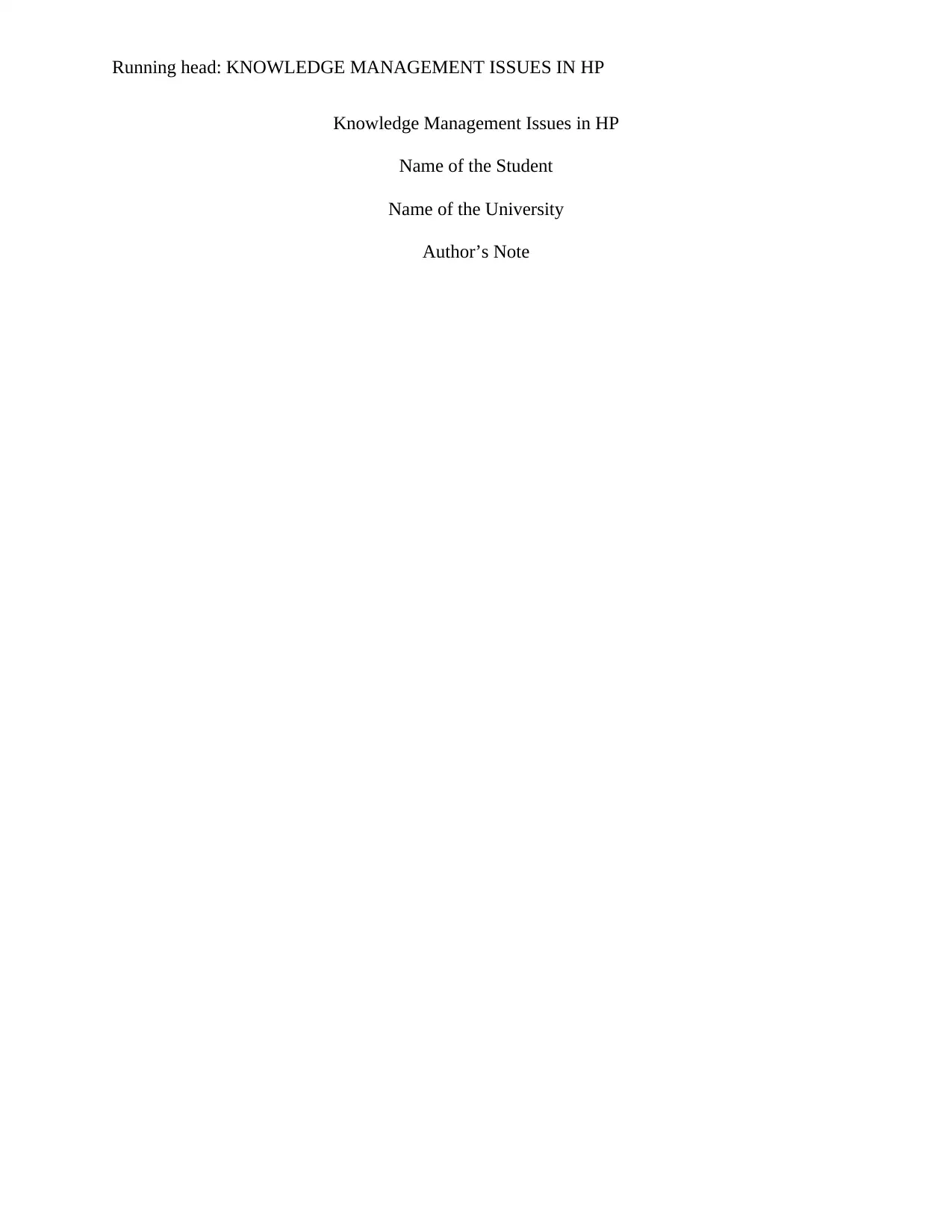
Running head: KNOWLEDGE MANAGEMENT ISSUES IN HP
Knowledge Management Issues in HP
Name of the Student
Name of the University
Author’s Note
Knowledge Management Issues in HP
Name of the Student
Name of the University
Author’s Note
Paraphrase This Document
Need a fresh take? Get an instant paraphrase of this document with our AI Paraphraser
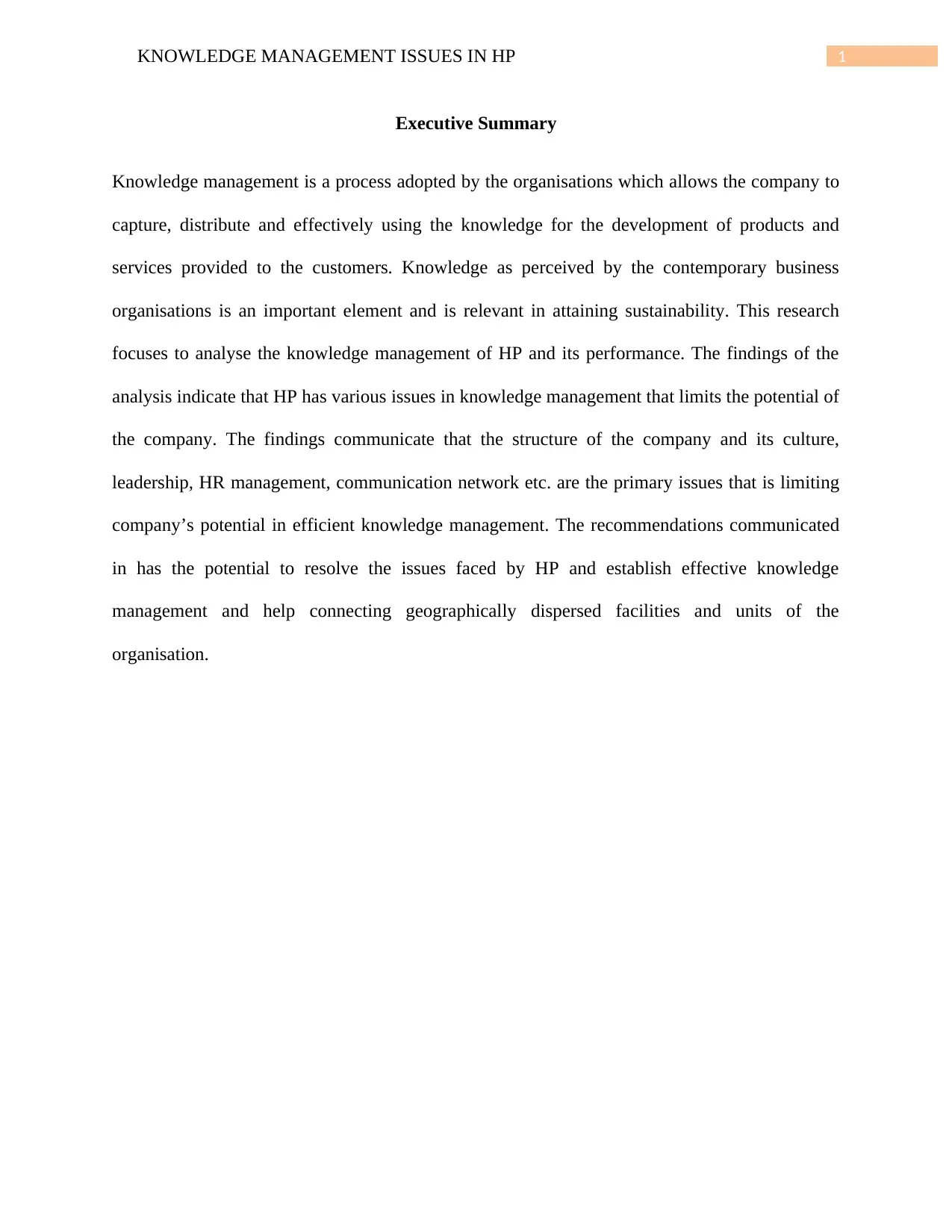
1KNOWLEDGE MANAGEMENT ISSUES IN HP
Executive Summary
Knowledge management is a process adopted by the organisations which allows the company to
capture, distribute and effectively using the knowledge for the development of products and
services provided to the customers. Knowledge as perceived by the contemporary business
organisations is an important element and is relevant in attaining sustainability. This research
focuses to analyse the knowledge management of HP and its performance. The findings of the
analysis indicate that HP has various issues in knowledge management that limits the potential of
the company. The findings communicate that the structure of the company and its culture,
leadership, HR management, communication network etc. are the primary issues that is limiting
company’s potential in efficient knowledge management. The recommendations communicated
in has the potential to resolve the issues faced by HP and establish effective knowledge
management and help connecting geographically dispersed facilities and units of the
organisation.
Executive Summary
Knowledge management is a process adopted by the organisations which allows the company to
capture, distribute and effectively using the knowledge for the development of products and
services provided to the customers. Knowledge as perceived by the contemporary business
organisations is an important element and is relevant in attaining sustainability. This research
focuses to analyse the knowledge management of HP and its performance. The findings of the
analysis indicate that HP has various issues in knowledge management that limits the potential of
the company. The findings communicate that the structure of the company and its culture,
leadership, HR management, communication network etc. are the primary issues that is limiting
company’s potential in efficient knowledge management. The recommendations communicated
in has the potential to resolve the issues faced by HP and establish effective knowledge
management and help connecting geographically dispersed facilities and units of the
organisation.
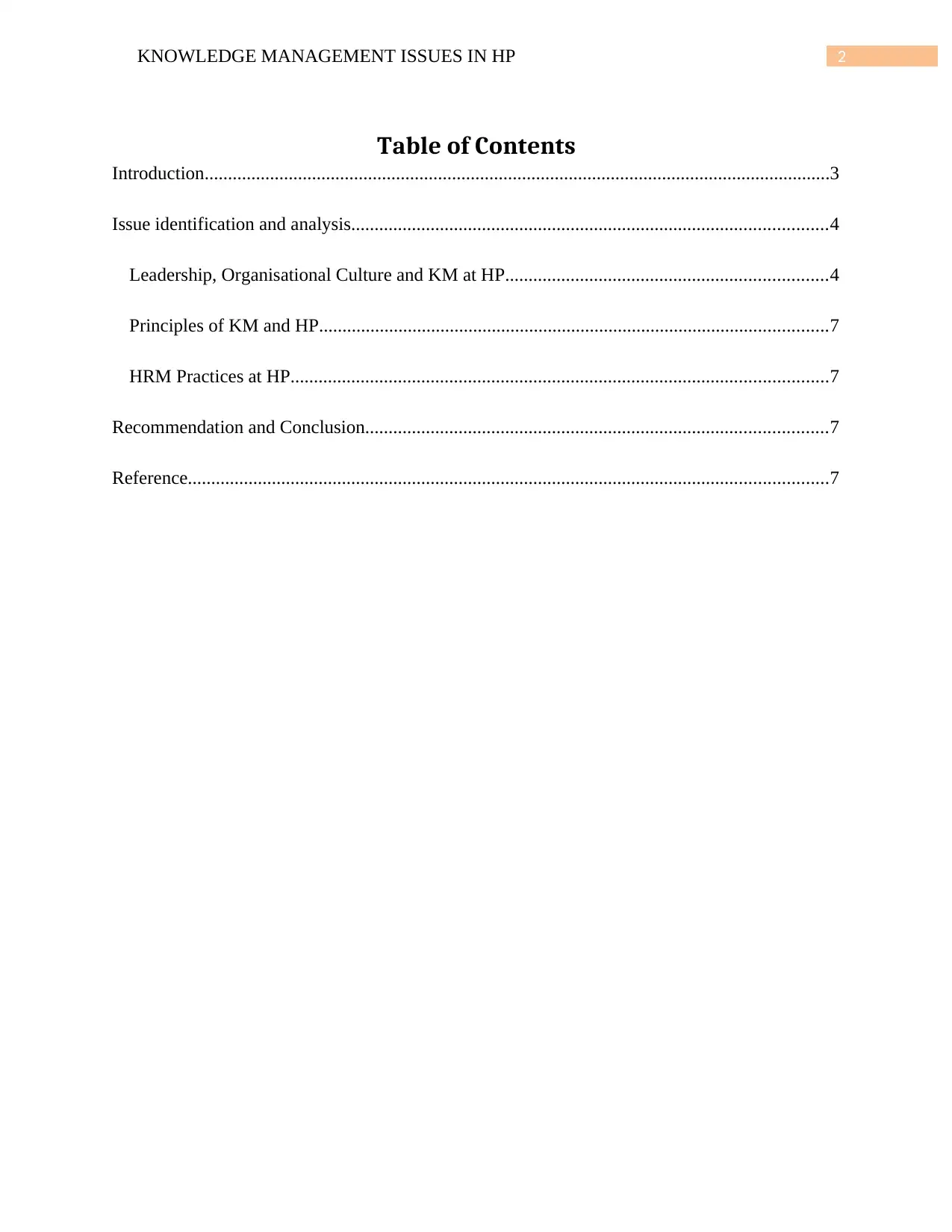
2KNOWLEDGE MANAGEMENT ISSUES IN HP
Table of Contents
Introduction......................................................................................................................................3
Issue identification and analysis......................................................................................................4
Leadership, Organisational Culture and KM at HP.....................................................................4
Principles of KM and HP.............................................................................................................7
HRM Practices at HP...................................................................................................................7
Recommendation and Conclusion...................................................................................................7
Reference.........................................................................................................................................7
Table of Contents
Introduction......................................................................................................................................3
Issue identification and analysis......................................................................................................4
Leadership, Organisational Culture and KM at HP.....................................................................4
Principles of KM and HP.............................................................................................................7
HRM Practices at HP...................................................................................................................7
Recommendation and Conclusion...................................................................................................7
Reference.........................................................................................................................................7
⊘ This is a preview!⊘
Do you want full access?
Subscribe today to unlock all pages.

Trusted by 1+ million students worldwide

3KNOWLEDGE MANAGEMENT ISSUES IN HP
Introduction
This report aims to identify and analyse the issues of knowledge management present in
the global technology giant, Hewlett-Packard. Knowledge management as argued by Noruzy et
al. (2013) is a process adopted by the organisations which allows the company to capture,
distribute and effectively using the knowledge for the development of products and services
provided to the customers. Knowledge as perceived by the contemporary business organisations
is an important element and is relevant in attaining sustainability. This is because every tangible
or intangible factors associated with business operation is considered as knowledge. It is often
associated with the common factors like employees, customers, money, leverage, learning,
flexibility, power and competitive advantage. Hence, it makes it important for the companies to
look after the accumulation, distribution and utilisation of knowledge for attain sustainability in
the competitive market. In other words, knowledge based organisations have to constantly update
their knowledge database for keeping themselves up to date. This will keep them aware of the
market condition. The company then have to circulate the accumulate knowledge in various
section of the organisation. However, accumulation and distribution of knowledge is not
sufficient for bringing sustainability in the competitive market. They require utilising the
knowledge to bring sustainability through advancement of the business process as per the
requirement communicated in the knowledge acquired. A number of principles guide the
knowledge management process in an organisation. These are the principles developed for
addressing the commonly faced by the organisation managing their knowledge (Geisler and
Wickramasinghe 2015). The principles related to leadership and organisational culture,
communities of practice and human resource management will be discussed in the following in
accordance to the issues of found in HP. The issues present in the case of HP will be identified
Introduction
This report aims to identify and analyse the issues of knowledge management present in
the global technology giant, Hewlett-Packard. Knowledge management as argued by Noruzy et
al. (2013) is a process adopted by the organisations which allows the company to capture,
distribute and effectively using the knowledge for the development of products and services
provided to the customers. Knowledge as perceived by the contemporary business organisations
is an important element and is relevant in attaining sustainability. This is because every tangible
or intangible factors associated with business operation is considered as knowledge. It is often
associated with the common factors like employees, customers, money, leverage, learning,
flexibility, power and competitive advantage. Hence, it makes it important for the companies to
look after the accumulation, distribution and utilisation of knowledge for attain sustainability in
the competitive market. In other words, knowledge based organisations have to constantly update
their knowledge database for keeping themselves up to date. This will keep them aware of the
market condition. The company then have to circulate the accumulate knowledge in various
section of the organisation. However, accumulation and distribution of knowledge is not
sufficient for bringing sustainability in the competitive market. They require utilising the
knowledge to bring sustainability through advancement of the business process as per the
requirement communicated in the knowledge acquired. A number of principles guide the
knowledge management process in an organisation. These are the principles developed for
addressing the commonly faced by the organisation managing their knowledge (Geisler and
Wickramasinghe 2015). The principles related to leadership and organisational culture,
communities of practice and human resource management will be discussed in the following in
accordance to the issues of found in HP. The issues present in the case of HP will be identified
Paraphrase This Document
Need a fresh take? Get an instant paraphrase of this document with our AI Paraphraser

4KNOWLEDGE MANAGEMENT ISSUES IN HP
and analysed in the report. The report also provides recommendation for overcoming the
knowledge management issues identified in the case.
Issue identification and analysis
Leadership, Organisational Culture and KM at HP
One of the primary issues that can be identified in the case of HP is the leadership and
cultural issue. This can again be attributed to the organisational structure. HP has a decentralised
structure that allows the units to operate as single autonomous group. This again facilitates in the
development of autonomous culture in the single units. Hence, the circulation and distribution of
the developed knowledge is restricted into the individual departments. Moreover, the knowledge
educators and trainers reflects reluctant attitude in sharing their knowledge with other similar
groups that potentially restricts the capabilities for the overall organisation. HP as a united
organisation has little information about the extent of its actual knowledge database.
According to Taylor (2013), it is important from an organisation to develop an integrated
structure for increased efficiency in knowledge management. This further requires an efficient
leadership approach for motivating the employees to take part in the knowledge sharing process.
Decentralised structure of HP has definitely facilitated them in directing employees’ brainpower
towards business-specific focus. This can be attributed for the business success. Moreover, this
helped them establishing an autonomous culture that developed an open and high level of
information sharing among the autonomous groups. This caused them in considering
decentralised structure even after failing in knowledge management in the overall organisation
and connecting the units through channelizing the knowledge throughout the units.
and analysed in the report. The report also provides recommendation for overcoming the
knowledge management issues identified in the case.
Issue identification and analysis
Leadership, Organisational Culture and KM at HP
One of the primary issues that can be identified in the case of HP is the leadership and
cultural issue. This can again be attributed to the organisational structure. HP has a decentralised
structure that allows the units to operate as single autonomous group. This again facilitates in the
development of autonomous culture in the single units. Hence, the circulation and distribution of
the developed knowledge is restricted into the individual departments. Moreover, the knowledge
educators and trainers reflects reluctant attitude in sharing their knowledge with other similar
groups that potentially restricts the capabilities for the overall organisation. HP as a united
organisation has little information about the extent of its actual knowledge database.
According to Taylor (2013), it is important from an organisation to develop an integrated
structure for increased efficiency in knowledge management. This further requires an efficient
leadership approach for motivating the employees to take part in the knowledge sharing process.
Decentralised structure of HP has definitely facilitated them in directing employees’ brainpower
towards business-specific focus. This can be attributed for the business success. Moreover, this
helped them establishing an autonomous culture that developed an open and high level of
information sharing among the autonomous groups. This caused them in considering
decentralised structure even after failing in knowledge management in the overall organisation
and connecting the units through channelizing the knowledge throughout the units.

5KNOWLEDGE MANAGEMENT ISSUES IN HP
Supervision is one of the essential factors involved in knowledge management of an
organisation. Leaders facilitate in motivating the employees in sharing the knowledge. These are
responsible for motivating the employee and promote knowledge sharing throughout the
organisation. The motivational leaderships will help in communicating the goals to the group
members so that they are able to maximise their potentials (Casey et al. 2013). It also maintains
the institutional morale in against the negative attitudes. Motivation keeps the employees
confident in all conditions and they perform more efficiently. Motivational leaders show
commitments to the tasks of the others in order to demonstrate the commitment to the team as
well as the mission of the company. Moreover, this can help in gaining a positive attitude,
creativity and optimism in every projects (Hislop 2013).
As explained by Carmeli, Gelbard and Reiter-Palmon (2013) the role of a leader is not
only to motivate the employees in knowledge sharing, but also in tracking the performance of the
employees in the process of sharing. They are responsible for developing culture within the
groups that has the potential to motivate the employees in taking time for sharing the knowledge.
The employees share courage and responsibility in doing their tasks backed up by proper
knowledge (Tseng and Kuo 2014). HP’s autonomous culture has successfully established
knowledge sharing within the autonomous groups that considerably increases the group
performance. However, this culture according to Mueller (2014) fails to satisfy the knowledge
management need of the overall organisational structure as it restricts the knowledge flow in the
overall structure.
Hence, it is necessary for the organisation to implement leadership for enabling
knowledge sharing between the units of HP. It is required for motivating the employees for
taking part in the knowledge sharing process. As put forward by Mittal and Dhar (2015),
Supervision is one of the essential factors involved in knowledge management of an
organisation. Leaders facilitate in motivating the employees in sharing the knowledge. These are
responsible for motivating the employee and promote knowledge sharing throughout the
organisation. The motivational leaderships will help in communicating the goals to the group
members so that they are able to maximise their potentials (Casey et al. 2013). It also maintains
the institutional morale in against the negative attitudes. Motivation keeps the employees
confident in all conditions and they perform more efficiently. Motivational leaders show
commitments to the tasks of the others in order to demonstrate the commitment to the team as
well as the mission of the company. Moreover, this can help in gaining a positive attitude,
creativity and optimism in every projects (Hislop 2013).
As explained by Carmeli, Gelbard and Reiter-Palmon (2013) the role of a leader is not
only to motivate the employees in knowledge sharing, but also in tracking the performance of the
employees in the process of sharing. They are responsible for developing culture within the
groups that has the potential to motivate the employees in taking time for sharing the knowledge.
The employees share courage and responsibility in doing their tasks backed up by proper
knowledge (Tseng and Kuo 2014). HP’s autonomous culture has successfully established
knowledge sharing within the autonomous groups that considerably increases the group
performance. However, this culture according to Mueller (2014) fails to satisfy the knowledge
management need of the overall organisational structure as it restricts the knowledge flow in the
overall structure.
Hence, it is necessary for the organisation to implement leadership for enabling
knowledge sharing between the units of HP. It is required for motivating the employees for
taking part in the knowledge sharing process. As put forward by Mittal and Dhar (2015),
⊘ This is a preview!⊘
Do you want full access?
Subscribe today to unlock all pages.

Trusted by 1+ million students worldwide
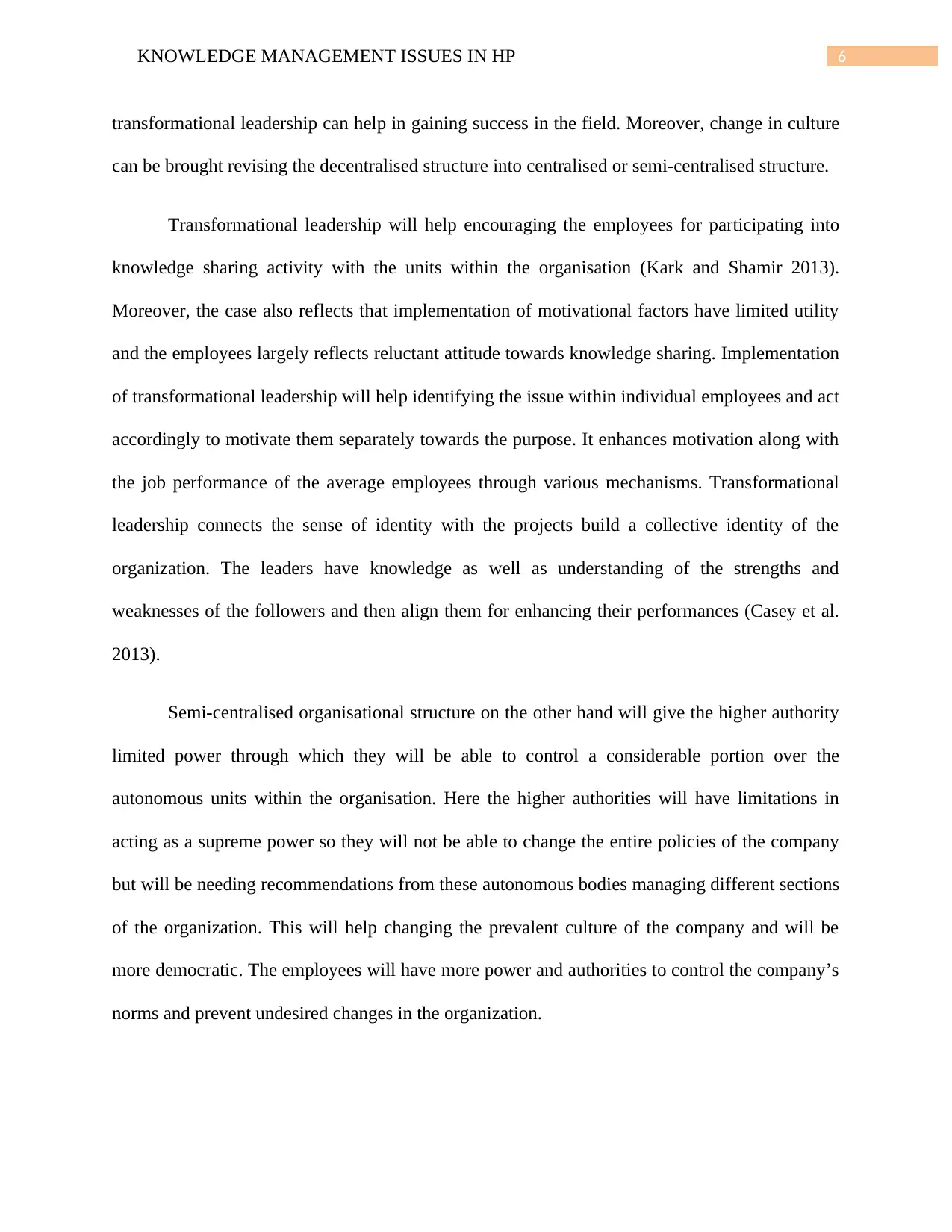
6KNOWLEDGE MANAGEMENT ISSUES IN HP
transformational leadership can help in gaining success in the field. Moreover, change in culture
can be brought revising the decentralised structure into centralised or semi-centralised structure.
Transformational leadership will help encouraging the employees for participating into
knowledge sharing activity with the units within the organisation (Kark and Shamir 2013).
Moreover, the case also reflects that implementation of motivational factors have limited utility
and the employees largely reflects reluctant attitude towards knowledge sharing. Implementation
of transformational leadership will help identifying the issue within individual employees and act
accordingly to motivate them separately towards the purpose. It enhances motivation along with
the job performance of the average employees through various mechanisms. Transformational
leadership connects the sense of identity with the projects build a collective identity of the
organization. The leaders have knowledge as well as understanding of the strengths and
weaknesses of the followers and then align them for enhancing their performances (Casey et al.
2013).
Semi-centralised organisational structure on the other hand will give the higher authority
limited power through which they will be able to control a considerable portion over the
autonomous units within the organisation. Here the higher authorities will have limitations in
acting as a supreme power so they will not be able to change the entire policies of the company
but will be needing recommendations from these autonomous bodies managing different sections
of the organization. This will help changing the prevalent culture of the company and will be
more democratic. The employees will have more power and authorities to control the company’s
norms and prevent undesired changes in the organization.
transformational leadership can help in gaining success in the field. Moreover, change in culture
can be brought revising the decentralised structure into centralised or semi-centralised structure.
Transformational leadership will help encouraging the employees for participating into
knowledge sharing activity with the units within the organisation (Kark and Shamir 2013).
Moreover, the case also reflects that implementation of motivational factors have limited utility
and the employees largely reflects reluctant attitude towards knowledge sharing. Implementation
of transformational leadership will help identifying the issue within individual employees and act
accordingly to motivate them separately towards the purpose. It enhances motivation along with
the job performance of the average employees through various mechanisms. Transformational
leadership connects the sense of identity with the projects build a collective identity of the
organization. The leaders have knowledge as well as understanding of the strengths and
weaknesses of the followers and then align them for enhancing their performances (Casey et al.
2013).
Semi-centralised organisational structure on the other hand will give the higher authority
limited power through which they will be able to control a considerable portion over the
autonomous units within the organisation. Here the higher authorities will have limitations in
acting as a supreme power so they will not be able to change the entire policies of the company
but will be needing recommendations from these autonomous bodies managing different sections
of the organization. This will help changing the prevalent culture of the company and will be
more democratic. The employees will have more power and authorities to control the company’s
norms and prevent undesired changes in the organization.
Paraphrase This Document
Need a fresh take? Get an instant paraphrase of this document with our AI Paraphraser

7KNOWLEDGE MANAGEMENT ISSUES IN HP
Principles of KM and HP
HP case of knowledge management reflects failure in holding some of the primary
principles of knowledge management that are requirement of leadership, simplicity of the
knowledge, knowledge sharing culture, knowledge access and finally the community of practice.
The company is failing in addressing the mentioned principles due to various organisational
factors that is restricting them from making the right decision and establishing necessary
knowledge management for organisational success in the competitive market.
Leadership issue in the knowledge management of the organisation can be attributed due
to the decentralised structure. This limits the upper management to direct the workforce
according to their need of knowledge management. The company however have developed an
autonomous culture in their separate units that in turn helped them to attain greater success in the
specific fields. Autonomy of the organisational units again imposes restriction in knowledge
management by denying circulation of knowledge developed (Hau et al. 2013). This restricts the
organisation to develop understanding of the actual volume of their stored knowledge. Moreover,
this restricts them from exploring and utilising the knowledge when required. Principles of
simplicity in knowledge management on the other hand prioritise the need of simplification of
the knowledge. The knowledge shared needs to be simple enough, so that the stakeholders
utilising it can develop understanding of the knowledge and utilise it according to the need.
Knowledge sharing culture on the other hand, as mentioned in the earlier section is absent
in the organisation. According to Titi Amayah (2013), knowledge sharing is one of the important
activity enlisted under knowledge management process. This principle of knowledge
management seeks the organisation to establish efficient knowledge sharing. In other words, it is
the circulation of developed knowledge within the organisation enabling various departments to
Principles of KM and HP
HP case of knowledge management reflects failure in holding some of the primary
principles of knowledge management that are requirement of leadership, simplicity of the
knowledge, knowledge sharing culture, knowledge access and finally the community of practice.
The company is failing in addressing the mentioned principles due to various organisational
factors that is restricting them from making the right decision and establishing necessary
knowledge management for organisational success in the competitive market.
Leadership issue in the knowledge management of the organisation can be attributed due
to the decentralised structure. This limits the upper management to direct the workforce
according to their need of knowledge management. The company however have developed an
autonomous culture in their separate units that in turn helped them to attain greater success in the
specific fields. Autonomy of the organisational units again imposes restriction in knowledge
management by denying circulation of knowledge developed (Hau et al. 2013). This restricts the
organisation to develop understanding of the actual volume of their stored knowledge. Moreover,
this restricts them from exploring and utilising the knowledge when required. Principles of
simplicity in knowledge management on the other hand prioritise the need of simplification of
the knowledge. The knowledge shared needs to be simple enough, so that the stakeholders
utilising it can develop understanding of the knowledge and utilise it according to the need.
Knowledge sharing culture on the other hand, as mentioned in the earlier section is absent
in the organisation. According to Titi Amayah (2013), knowledge sharing is one of the important
activity enlisted under knowledge management process. This principle of knowledge
management seeks the organisation to establish efficient knowledge sharing. In other words, it is
the circulation of developed knowledge within the organisation enabling various departments to

8KNOWLEDGE MANAGEMENT ISSUES IN HP
gain access to the knowledge that can be used for directing the business accordingly in
accordance with the respected units. This synchronisation between the units using knowledge
management helps the organisations to explore greater efficiency, help aligning the units of the
organisation, and direct it towards the attainment of the same overall goal set by the organisation.
Lastly, principle of community of practice in knowledge management is the intranet
network designed by the management of the organisation. This helps in channelizing the
knowledge between the stakeholders of the organisation. This helps in the utilisation of the
knowledge developed. The manager of HP, however, needs to develop understanding of the
knowledge requirement and possessed knowledge of the company for designing the appropriate
network that will make the knowledge available to the stakeholders associated. The
contemporary knowledge management process incorporates the intranet connection between the
geographically dispersed units of the organisation for establishing knowledge sharing between
the communities. Establishment of the same further help in sorting the knowledge depending on
the content that will make is easy for the stakeholders in accessing the shared knowledge
(Majchrzak et al. 2013). Development of social intranet software can be recommended for
resolving the internal communication issues and information sharing. The internal stakeholders
like employees belonging from other units of the organisation can explore the knowledge at the
time of need. Establishment of customer helpline portal on the other hand can be used for
satisfying the customer need of knowledge.
HRM Practices at HP
Company is also facing issues in the human resource management as it is failing in
facilitating knowledge management. This can be considered as a knowledge management crisis
in the company. HP holds firm grip on both the external sources of knowledge and internal
gain access to the knowledge that can be used for directing the business accordingly in
accordance with the respected units. This synchronisation between the units using knowledge
management helps the organisations to explore greater efficiency, help aligning the units of the
organisation, and direct it towards the attainment of the same overall goal set by the organisation.
Lastly, principle of community of practice in knowledge management is the intranet
network designed by the management of the organisation. This helps in channelizing the
knowledge between the stakeholders of the organisation. This helps in the utilisation of the
knowledge developed. The manager of HP, however, needs to develop understanding of the
knowledge requirement and possessed knowledge of the company for designing the appropriate
network that will make the knowledge available to the stakeholders associated. The
contemporary knowledge management process incorporates the intranet connection between the
geographically dispersed units of the organisation for establishing knowledge sharing between
the communities. Establishment of the same further help in sorting the knowledge depending on
the content that will make is easy for the stakeholders in accessing the shared knowledge
(Majchrzak et al. 2013). Development of social intranet software can be recommended for
resolving the internal communication issues and information sharing. The internal stakeholders
like employees belonging from other units of the organisation can explore the knowledge at the
time of need. Establishment of customer helpline portal on the other hand can be used for
satisfying the customer need of knowledge.
HRM Practices at HP
Company is also facing issues in the human resource management as it is failing in
facilitating knowledge management. This can be considered as a knowledge management crisis
in the company. HP holds firm grip on both the external sources of knowledge and internal
⊘ This is a preview!⊘
Do you want full access?
Subscribe today to unlock all pages.

Trusted by 1+ million students worldwide
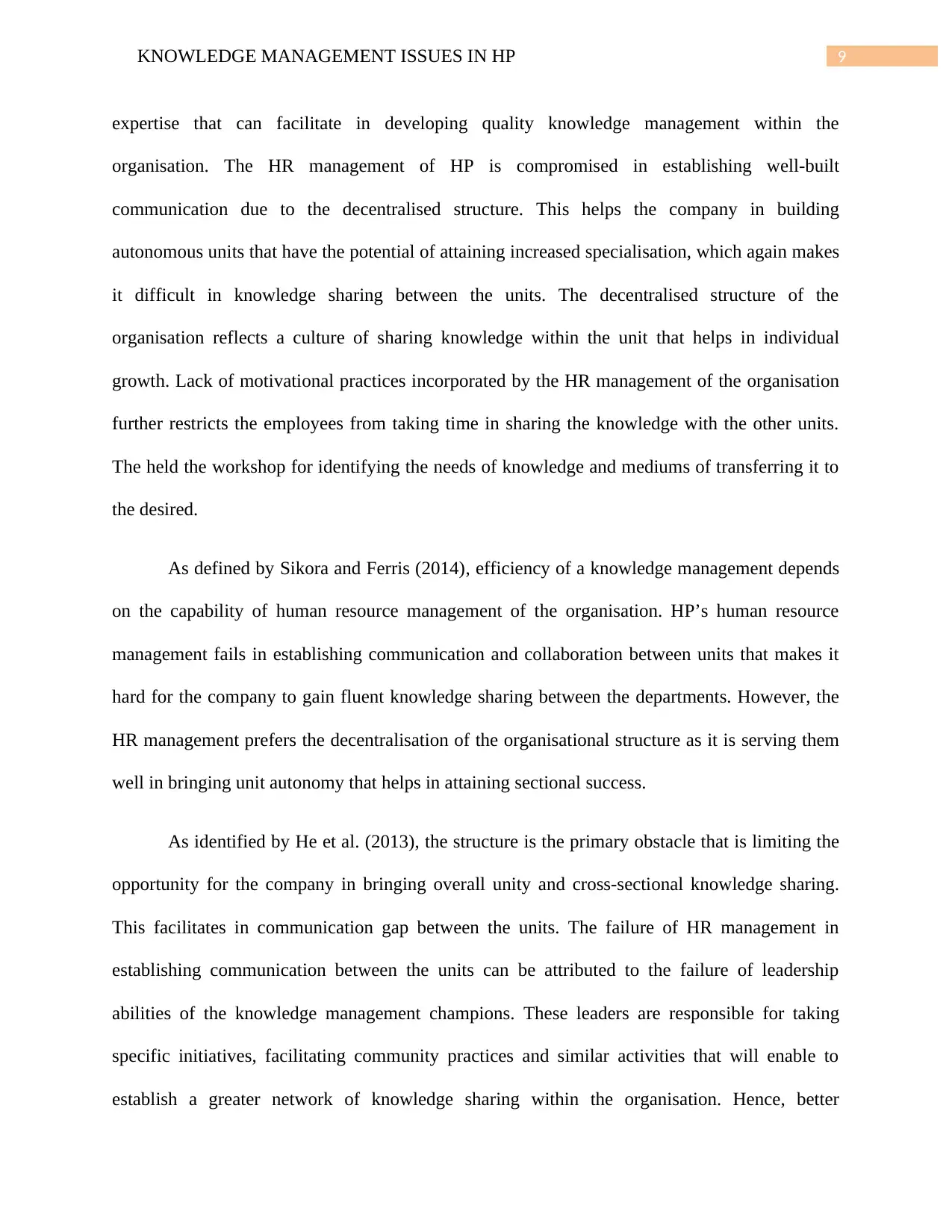
9KNOWLEDGE MANAGEMENT ISSUES IN HP
expertise that can facilitate in developing quality knowledge management within the
organisation. The HR management of HP is compromised in establishing well-built
communication due to the decentralised structure. This helps the company in building
autonomous units that have the potential of attaining increased specialisation, which again makes
it difficult in knowledge sharing between the units. The decentralised structure of the
organisation reflects a culture of sharing knowledge within the unit that helps in individual
growth. Lack of motivational practices incorporated by the HR management of the organisation
further restricts the employees from taking time in sharing the knowledge with the other units.
The held the workshop for identifying the needs of knowledge and mediums of transferring it to
the desired.
As defined by Sikora and Ferris (2014), efficiency of a knowledge management depends
on the capability of human resource management of the organisation. HP’s human resource
management fails in establishing communication and collaboration between units that makes it
hard for the company to gain fluent knowledge sharing between the departments. However, the
HR management prefers the decentralisation of the organisational structure as it is serving them
well in bringing unit autonomy that helps in attaining sectional success.
As identified by He et al. (2013), the structure is the primary obstacle that is limiting the
opportunity for the company in bringing overall unity and cross-sectional knowledge sharing.
This facilitates in communication gap between the units. The failure of HR management in
establishing communication between the units can be attributed to the failure of leadership
abilities of the knowledge management champions. These leaders are responsible for taking
specific initiatives, facilitating community practices and similar activities that will enable to
establish a greater network of knowledge sharing within the organisation. Hence, better
expertise that can facilitate in developing quality knowledge management within the
organisation. The HR management of HP is compromised in establishing well-built
communication due to the decentralised structure. This helps the company in building
autonomous units that have the potential of attaining increased specialisation, which again makes
it difficult in knowledge sharing between the units. The decentralised structure of the
organisation reflects a culture of sharing knowledge within the unit that helps in individual
growth. Lack of motivational practices incorporated by the HR management of the organisation
further restricts the employees from taking time in sharing the knowledge with the other units.
The held the workshop for identifying the needs of knowledge and mediums of transferring it to
the desired.
As defined by Sikora and Ferris (2014), efficiency of a knowledge management depends
on the capability of human resource management of the organisation. HP’s human resource
management fails in establishing communication and collaboration between units that makes it
hard for the company to gain fluent knowledge sharing between the departments. However, the
HR management prefers the decentralisation of the organisational structure as it is serving them
well in bringing unit autonomy that helps in attaining sectional success.
As identified by He et al. (2013), the structure is the primary obstacle that is limiting the
opportunity for the company in bringing overall unity and cross-sectional knowledge sharing.
This facilitates in communication gap between the units. The failure of HR management in
establishing communication between the units can be attributed to the failure of leadership
abilities of the knowledge management champions. These leaders are responsible for taking
specific initiatives, facilitating community practices and similar activities that will enable to
establish a greater network of knowledge sharing within the organisation. Hence, better
Paraphrase This Document
Need a fresh take? Get an instant paraphrase of this document with our AI Paraphraser
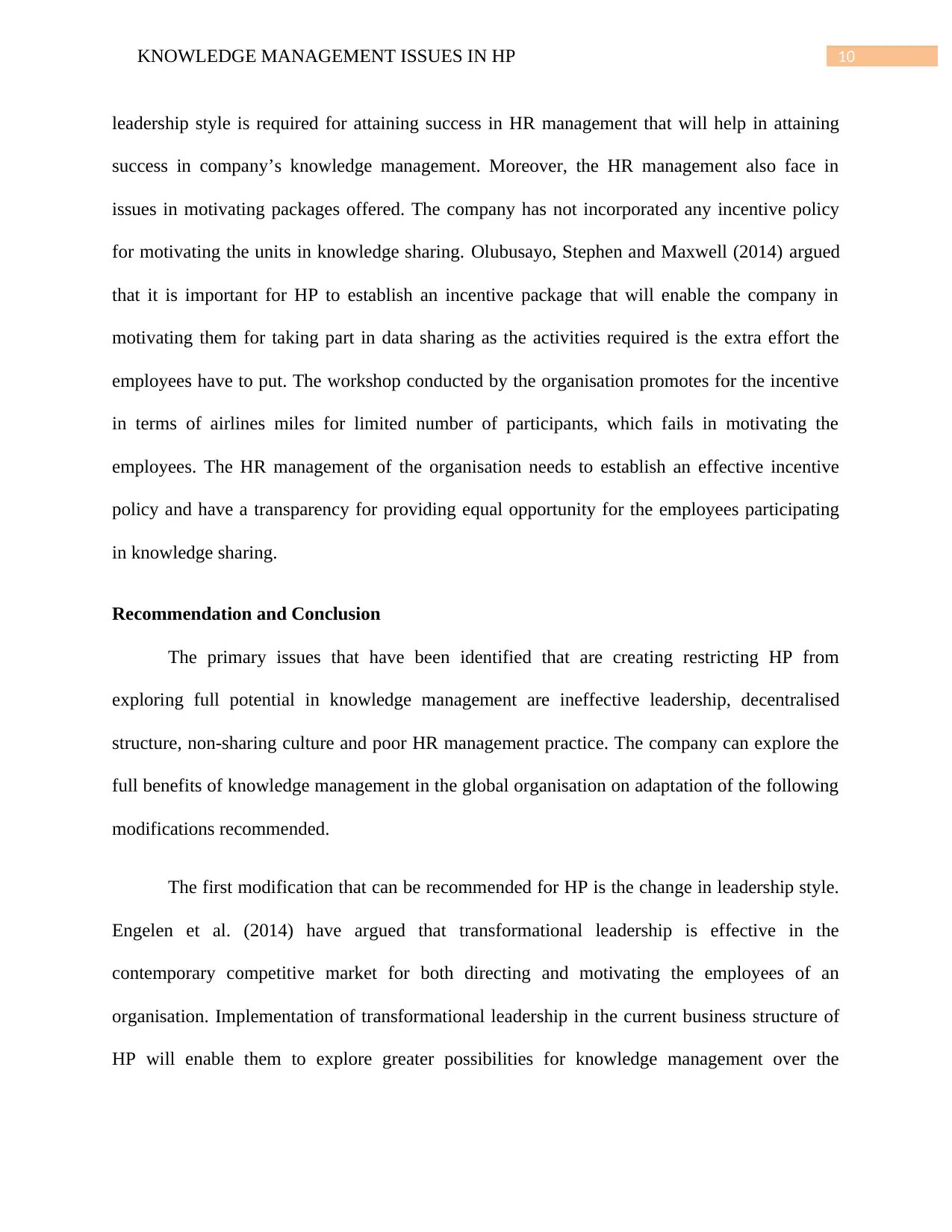
10KNOWLEDGE MANAGEMENT ISSUES IN HP
leadership style is required for attaining success in HR management that will help in attaining
success in company’s knowledge management. Moreover, the HR management also face in
issues in motivating packages offered. The company has not incorporated any incentive policy
for motivating the units in knowledge sharing. Olubusayo, Stephen and Maxwell (2014) argued
that it is important for HP to establish an incentive package that will enable the company in
motivating them for taking part in data sharing as the activities required is the extra effort the
employees have to put. The workshop conducted by the organisation promotes for the incentive
in terms of airlines miles for limited number of participants, which fails in motivating the
employees. The HR management of the organisation needs to establish an effective incentive
policy and have a transparency for providing equal opportunity for the employees participating
in knowledge sharing.
Recommendation and Conclusion
The primary issues that have been identified that are creating restricting HP from
exploring full potential in knowledge management are ineffective leadership, decentralised
structure, non-sharing culture and poor HR management practice. The company can explore the
full benefits of knowledge management in the global organisation on adaptation of the following
modifications recommended.
The first modification that can be recommended for HP is the change in leadership style.
Engelen et al. (2014) have argued that transformational leadership is effective in the
contemporary competitive market for both directing and motivating the employees of an
organisation. Implementation of transformational leadership in the current business structure of
HP will enable them to explore greater possibilities for knowledge management over the
leadership style is required for attaining success in HR management that will help in attaining
success in company’s knowledge management. Moreover, the HR management also face in
issues in motivating packages offered. The company has not incorporated any incentive policy
for motivating the units in knowledge sharing. Olubusayo, Stephen and Maxwell (2014) argued
that it is important for HP to establish an incentive package that will enable the company in
motivating them for taking part in data sharing as the activities required is the extra effort the
employees have to put. The workshop conducted by the organisation promotes for the incentive
in terms of airlines miles for limited number of participants, which fails in motivating the
employees. The HR management of the organisation needs to establish an effective incentive
policy and have a transparency for providing equal opportunity for the employees participating
in knowledge sharing.
Recommendation and Conclusion
The primary issues that have been identified that are creating restricting HP from
exploring full potential in knowledge management are ineffective leadership, decentralised
structure, non-sharing culture and poor HR management practice. The company can explore the
full benefits of knowledge management in the global organisation on adaptation of the following
modifications recommended.
The first modification that can be recommended for HP is the change in leadership style.
Engelen et al. (2014) have argued that transformational leadership is effective in the
contemporary competitive market for both directing and motivating the employees of an
organisation. Implementation of transformational leadership in the current business structure of
HP will enable them to explore greater possibilities for knowledge management over the
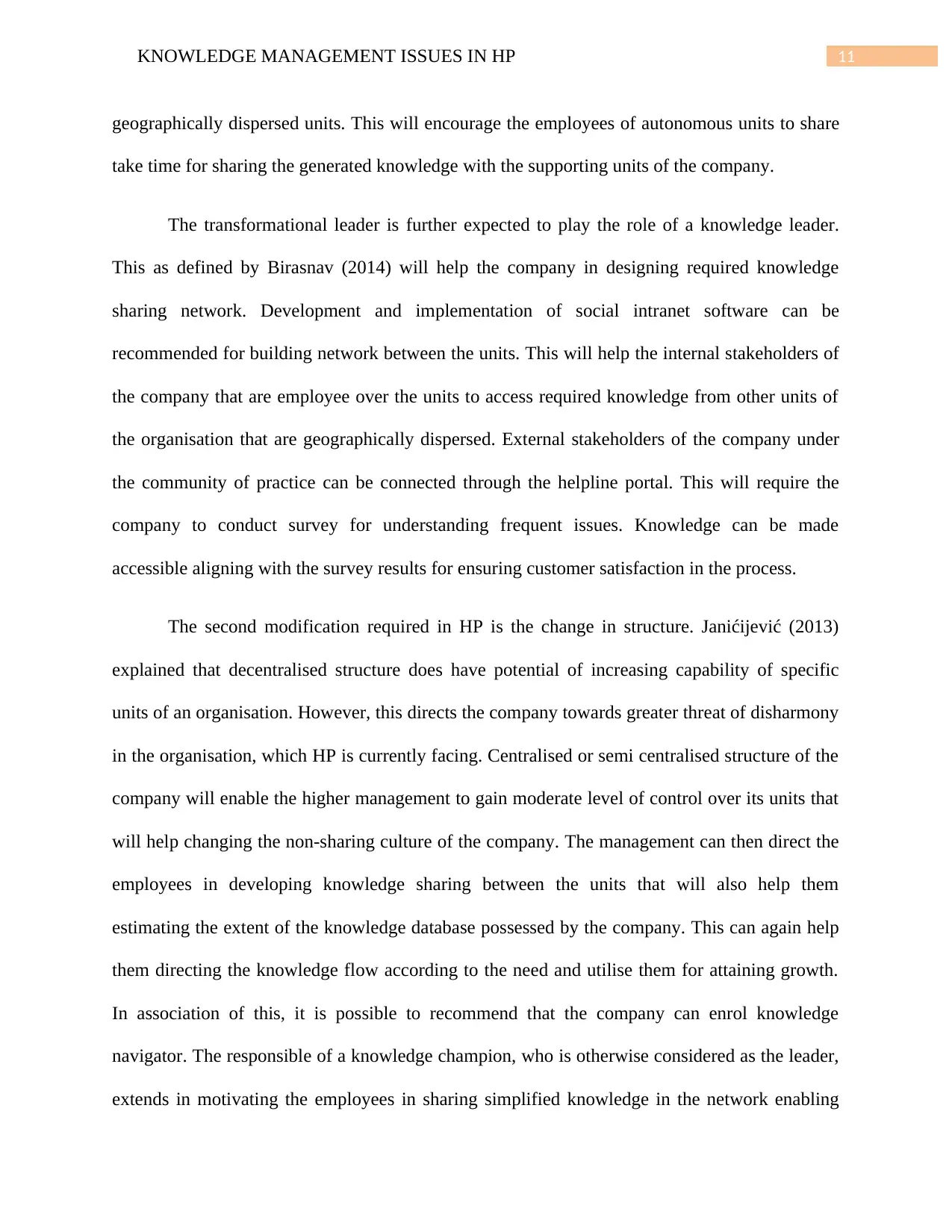
11KNOWLEDGE MANAGEMENT ISSUES IN HP
geographically dispersed units. This will encourage the employees of autonomous units to share
take time for sharing the generated knowledge with the supporting units of the company.
The transformational leader is further expected to play the role of a knowledge leader.
This as defined by Birasnav (2014) will help the company in designing required knowledge
sharing network. Development and implementation of social intranet software can be
recommended for building network between the units. This will help the internal stakeholders of
the company that are employee over the units to access required knowledge from other units of
the organisation that are geographically dispersed. External stakeholders of the company under
the community of practice can be connected through the helpline portal. This will require the
company to conduct survey for understanding frequent issues. Knowledge can be made
accessible aligning with the survey results for ensuring customer satisfaction in the process.
The second modification required in HP is the change in structure. Janićijević (2013)
explained that decentralised structure does have potential of increasing capability of specific
units of an organisation. However, this directs the company towards greater threat of disharmony
in the organisation, which HP is currently facing. Centralised or semi centralised structure of the
company will enable the higher management to gain moderate level of control over its units that
will help changing the non-sharing culture of the company. The management can then direct the
employees in developing knowledge sharing between the units that will also help them
estimating the extent of the knowledge database possessed by the company. This can again help
them directing the knowledge flow according to the need and utilise them for attaining growth.
In association of this, it is possible to recommend that the company can enrol knowledge
navigator. The responsible of a knowledge champion, who is otherwise considered as the leader,
extends in motivating the employees in sharing simplified knowledge in the network enabling
geographically dispersed units. This will encourage the employees of autonomous units to share
take time for sharing the generated knowledge with the supporting units of the company.
The transformational leader is further expected to play the role of a knowledge leader.
This as defined by Birasnav (2014) will help the company in designing required knowledge
sharing network. Development and implementation of social intranet software can be
recommended for building network between the units. This will help the internal stakeholders of
the company that are employee over the units to access required knowledge from other units of
the organisation that are geographically dispersed. External stakeholders of the company under
the community of practice can be connected through the helpline portal. This will require the
company to conduct survey for understanding frequent issues. Knowledge can be made
accessible aligning with the survey results for ensuring customer satisfaction in the process.
The second modification required in HP is the change in structure. Janićijević (2013)
explained that decentralised structure does have potential of increasing capability of specific
units of an organisation. However, this directs the company towards greater threat of disharmony
in the organisation, which HP is currently facing. Centralised or semi centralised structure of the
company will enable the higher management to gain moderate level of control over its units that
will help changing the non-sharing culture of the company. The management can then direct the
employees in developing knowledge sharing between the units that will also help them
estimating the extent of the knowledge database possessed by the company. This can again help
them directing the knowledge flow according to the need and utilise them for attaining growth.
In association of this, it is possible to recommend that the company can enrol knowledge
navigator. The responsible of a knowledge champion, who is otherwise considered as the leader,
extends in motivating the employees in sharing simplified knowledge in the network enabling
⊘ This is a preview!⊘
Do you want full access?
Subscribe today to unlock all pages.

Trusted by 1+ million students worldwide
1 out of 17
Related Documents
Your All-in-One AI-Powered Toolkit for Academic Success.
+13062052269
info@desklib.com
Available 24*7 on WhatsApp / Email
![[object Object]](/_next/static/media/star-bottom.7253800d.svg)
Unlock your academic potential
Copyright © 2020–2025 A2Z Services. All Rights Reserved. Developed and managed by ZUCOL.





